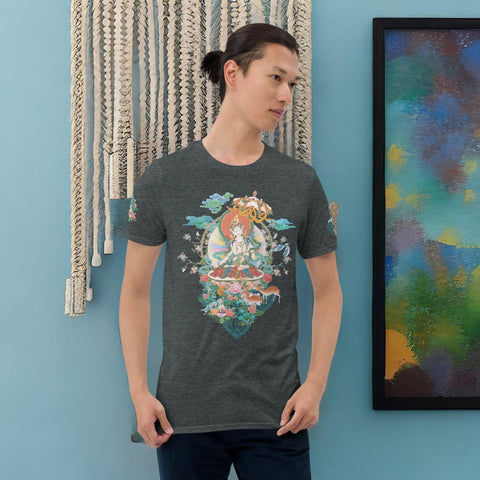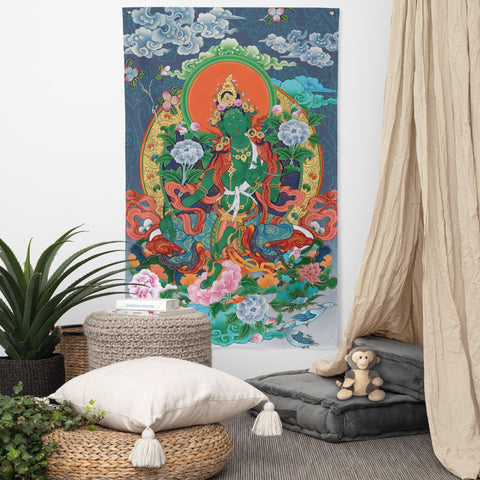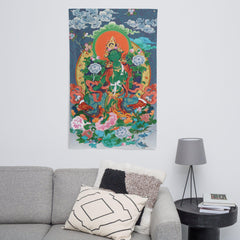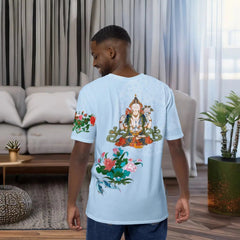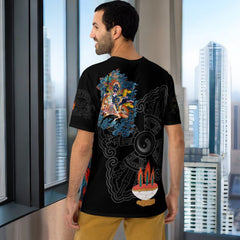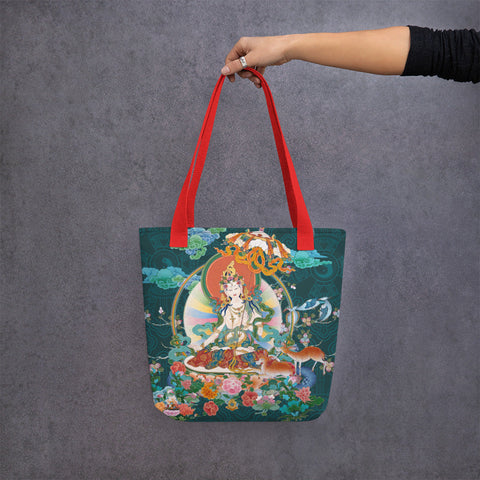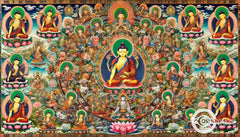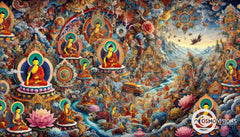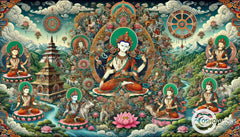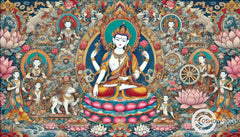Exploring the Sacred Goddess: White Tara Green Tara in Buddhist Meditation and Dharma Practice
Posted by Massimiliano Geraci

Are you feeling lost or seeking more depth in your spiritual journey? You might be looking for a way to connect with something greater, to find peace and understanding. In the vast ocean of Buddhist teachings, two radiant figures shine brightly as guides and protectors: White Tara and Green Tara. Tara, a prominent Buddhist figure, is revered as a female buddha, embodying universal compassion and enlightened activity.
Are you feeling lost or seeking more depth in your spiritual journey? You might be looking for a way to connect with something greater, to find peace and understanding. In the vast ocean of Buddhist teachings, two radiant figures shine brightly as guides and protectors: White Tara and Green Tara. Tara, a prominent Buddhist figure, is revered as a female buddha, embodying universal compassion and enlightened activity.
This blog post will explore the sacred roles of White Tara and Green Tara in Buddhist meditation and Dharma practice. We’ll examine these deities, their differences and similarities, and how they can positively impact your spiritual journey.
Integrating practices associated with these goddesses into your daily routine allows you to develop compassion and wisdom on your path to enlightenment. Get ready to deepen your understanding.
It shifts how we see and react to the world around us, guiding us on a path filled with compassion and understanding for all living beings.
The importance of the seed syllable of Tara in meditation practices
Key Takeaways
- White and green tara are important figures in Tibetan Buddhism. They symbolize compassion, protection, and enlightenment. White tara brings healing, long life, and prosperity, while Green tara is known for quick action and overcoming obstacles.
- Practicing meditations focused on these Taras can help individuals develop inner peace, compassion towards others, and progress on their spiritual journeys. Both deities have special mantras that are recited to invoke their qualities within the practitioner.
- The symbolism behind White Tara includes seven eyes for omniscient wisdom and a white lotus representing purity through enlightenment. Her mantra emphasizes longevity and health benefits for those who engage with it regularly.
- Different forms of Tara serve various aspects of life challenges; beyond White and Green Taras, there are many other colors like Red for passion, Yellow for wealth and proactive actions against difficulties.
- Incorporating practices related to these divine figures into daily routines can significantly transform one's mental state by promoting feelings of serenity and fostering a connection with deeper spiritual truths.
Understanding the Significance of White Tara in Vajrayana Buddhism
Moving from the broad overview, we delve into the heart of White Tara’s role in Vajrayana Buddhism. This sacred figure symbolizes endless compassion and protection for those facing suffering.
Known also as Sita Tara, she stands out as a beacon of hope and healing within Tibetan Buddhism. As a meditational deity, her essence is deeply intertwined with qualities like kindness and generosity, embodying the ultimate nature of Dharmakaya—the enlightened mind’s truest form.
White Tara is celebrated across all four major schools of Tibetan Buddhism, showcasing her universal appeal. Esteemed Buddhist scholars such as Nagarjuna and Atisha turned to her practice in ancient India and Tibet, seeking her blessings for long life, peace, prosperity, and health.
Her depiction—a deity adorned with elaborate decorations seated gracefully above a white moon disc on an open lotus—radiates serene compassion. Through engaging with White Tara’s mantra, practitioners aspire to awaken these enlightened qualities within themselves.
Who is White Tara and why is she important in Tibetan Buddhism?
White Tara is a guardian and comforting mother figure in the practice of Tibetan Buddhism. She offers endless care, generosity, and safety to those in pain. This Buddhist deity symbolizes long life, serenity, wealth, and good health.
Her enlightened actions aim to improve these aspects for both the individual practicing her teachings and others around them. White Tara’s practices are found across all main divisions of Tibetan Buddhism, showing her wide-reaching impact. White Tara embodies infinite compassion and is crucial in guiding practitioners toward enlightenment. She repeatedly vowed to be reborn in female form to aid sentient beings and attain Buddhahood.
Her importance is underscored by her role as the Mother of All Buddhas. This title reflects her nurturing presence in the spiritual journey of sentient beings toward awakening and relief from suffering.
With practices that highlight recitation of the White Tara mantra, followers seek protection under her watchful eyes—literally represented by the seven eyes on her body—and embrace through meditation rituals aimed at invoking her divine qualities.
The symbolism behind White Tara’s seven eyes and white lotus
Moving from the importance of White Tara in Tibetan Buddhism, we see her special features up close. She has seven eyes, with three on her face and one on each hand and foot. These are not just for seeing the way we do.
They symbolize her clear vision across the unity of all that is real and what we see around us. This divine being sees every creature, everywhere—feeling their joys and sorrows as if they were hers.
The white lotus held by White Tara stands out, too. It's far more than a pretty flower. It represents purity, showing how enlightenment shines through darkness like a moonbeam through night clouds.
Just as a lotus grows clean and beautiful from muddy water, this symbol tells us about rising above pain and trouble with grace. Through these signs—the seven eyes and the pure blooming lotus—White Tara reveals deep truths: watchful compassion for all life forms and the magnificent journey from shadow to light.

Comparing White Tara with Green Tara: Differences and Similarities
Transitioning from the intricate symbolism of White Tara’s seven eyes and white lotus, we examine the contrasts and parallels between White Tara and Green Tara. These sacred figures embody different yet complementary facets of compassion and protection in the Vajrayana Buddhist tradition. Green Tara, often depicted as the emerald-hued, one-faced and two-armed lady, emphasizes the union of wisdom and art through the positioning of her legs and the gestures of her hands.
Aspect White Tara Green Tara Symbolism Emphasizes peace, healing, and longevity. Focuses on swift action, overcoming fear and obstacles. Color Meaning: White symbolizes purity, truth, and completeness. Green represents growth, vigor, and a direct connection to nature. Role Seen as a protective mother figure. Regarded as a compassionate savior. Mantra Importance Associated with promoting long life and health. Linked to overcoming external and internal obstacles. Eye Symbolism Has seven eyes, symbolizing her omniscient wisdom. Typically depicted with two eyes, focusing on focused compassion. Practices Common in all four major schools of Tibetan Buddhism. More prevalent in the Mahayana tradition.
This table outlines the key aspects where White Tara and Green Tara differ in their symbolism, roles, and the emphasis of their mantras. Yet both aim to guide followers to compassion and enlightenment. While White Tara offers a protective and healing presence, Green Tara stands as a dynamic force for overcoming obstacles. Each holds a unique place in the hearts and practices of their devotees.
The Profound Meaning Behind White Tara's Mantra
White Tara’s mantra, “Om Tare Tuttare Ture Mama Ayuh-Jana Punye-Pustim Kuru Soha,” holds a deep message. Tara Tantra, an important aspect of Vajrayana Buddhism, includes prayers and teachings that highlight the origins and significance of the goddess Tara. It calls for long life, health, and prosperity. This sacred chant also asks for the growth of one’s virtues and peace of mind.
The power in these words helps people develop White Tara’s enlightened qualities within themselves. Recite her mantra with a pure heart and see your spirit soar. Practicing this mantra can guide one to liberation and enlightenment. It is not just a set of words but a beacon calling on White Tara’s protection against harm and suffering. Reciting brings you closer to embodying her compassion and wisdom.
Each syllable works as a key, unlocking profound spiritual insights and fostering an inner sanctuary of peace.
Deciphering the White Tara Mantra: A Deep Dive into Its Meaning
The White Tara mantra, "Om Tare Tuttare Ture Mama Ayuh-Jana Punye-Pustim Kuru Soha," is a powerful set of words in tantric practices. Each syllable carries deep significance, aimed at invoking the qualities of longevity, peace, and prosperity.
This mantra encourages practitioners to connect with the compassionate energy of White Tara, enhancing their spiritual journey to enlightenment. Reciting this mantra brings inner calm and also promotes physical well-being by focusing on health and long life.
This practice forms a crucial part of daily meditation for those following the Vajrayana path within Tibetan Buddhism. Through chanting these sacred words, individuals seek protection from harm and guidance to a more enlightened state.
It lays the groundwork for achieving harmony between body and spirit. Understanding how reciting White Tara's mantra promotes longevity and compassion makes it clear that these ancient sounds are keys to unlocking profound spiritual benefits.
How reciting White Tara's mantra promotes longevity and compassion
Reciting White Tara's mantra brings her enlightened compassion and peace into our lives. This sacred chant helps people live longer, healthier, and more peaceful lives. Each word in the mantra is a key that releases White Tara's healing energy.
It makes us think of kindness, pushing us to act with care for others.
This practice connects us with the Mother of Buddhas, making her qualities part of our daily life. Chanting encourages health and long life by filling our mind with positive energy.
The seed syllable "Tam" is central to Tara practice, especially in connecting with White Tara's compassionate and protective qualities. Meditating on this single sound helps bring about a deep transformation.
It acts as a key to unlock her healing energies and blessings. This syllable is envisioned at the heart's center during meditation sessions. By doing so, practitioners invoke the presence of White Tara, surrounding themselves with her white light that dispels fears, hurdles, and negative emotions.
Using "Tam" in meditation connects one deeply with White Tara’s essence. It embodies her pure energy and compassion, making it a powerful tool for those seeking protection and a long life.
Through this practice, people report experiencing significant positive changes in their lives—physically, emotionally, and spiritually. This method is widely respected across Tibetan Buddhism for its effectiveness in drawing closer to enlightenment by fostering a connection with the divine feminine aspect of the Buddha nature through compassion and wisdom.

Exploring the Various Forms of Tara in Tibetan Buddhism
Tibetan Buddhism shows us many faces of Tara, each with its own unique traits and purposes. The twenty one taras represent various forms and characteristics of Tara, each appearing as a completely enlightened Buddha in female form for the benefit of all beings. Green Tara swiftly saves beings from suffering, embodying fearless compassion.
Her mantra, “Om Tare Tuttare Ture Soha”, rings through temples and homes, calling for her help. Then there’s White Tara, a mother figure who wraps her followers in protective warmth.
She brings long life, peace, health, and prosperity. Her presence is powerful across all four major schools of Tibetan Buddhism.
Understanding the different aspects of Tara reveals a rich tapestry of spiritual practice. Red Tara draws devotees into deeper meditation practices with her passionate energy. Each form—be it green, white or red—serves as a guiding light to enlightenment.
These emanations reflect various qualities, such as compassion (Avalokiteśvara), wisdom (Prajñāpāramitā), and fearlessness (Durga). Devotees engage with Thangka paintings and sculptures to focus their meditations on these divine forms.
Practitioners deepen their connection to these celestial mothers through visualization techniques involving sacred lotus seats or the gentle glow of moon discs.
From Green Tara to Red Tara: Understanding the Different Aspects of Tara
In her many colors and forms, Tara embodies the female aspect of enlightenment and compassion within Vajrayana Buddhism. Each form carries unique attributes that cater to different needs and paths toward spiritual growth.
- Green Tara is known as the Mother of Liberation. She offers protection from physical and spiritual harm, often depicted with one leg outstretched ready to leap to the aid of those who call upon her.
- White Tara symbolizes purity, health, and longevity. Her seven eyes – two on the face, one on the forehead, and one on each hand and foot – allow her to see all suffering in the world so she can extend her protection across it.
- Red Tara represents fierce love and compassion. Her red color signifies action and a strong determination to transform negative energies into positive qualities like sensitivity and courage.
- Yellow Tara (Vasudhara) focuses on wealth and prosperity. This aspect concerns not only physical riches but also spiritual abundance, guiding practitioners to a path of generosity.
- Cittamani Tara, a special form of Green Tara within the Gelug school of Tibetan Buddhism founded by Je Tsongkhapa, emphasizes devotional practices that lead to enlightenment.
- Blue Tara (Ekajati), often associated with transmuting anger into wisdom, shows how powerful emotions can be transformed into vehicles for spiritual progress.
- Black Tara provides protection against severe hardships by helping practitioners remove obstacles on their spiritual journey.
- The mantra Om Tare Tuttare Ture Soha is common across different Taras, but its specific emphasis reflects each form's unique qualities and powers.
- Incorporating a statue or thangka of a particular Tara form into daily practice strengthens connection to that deity's enlightened qualities.
- Visualization plays a key role in Tara practice; imagining oneself as Tara or visualizing her presence allows for an intimate bond that enriches meditative experience. Forehead eye symbols across all Taras remind practitioners of the need for insight into reality beyond ordinary perception.
- Tara's lotus throne represents purity emerging from murky conditions; regardless of color or manifestation, this image teaches that enlightenment arises amidst worldly challenges.
- Practice sessions dedicated to specific Taras address distinct aspects of life’s struggles—reciting Red Tara’s mantra might focus on overcoming emotional obstacles while Yellow Tara’s would attract positive energies for success in endeavors.
These variations show how complex and adaptive Buddhist practice is; recognizing which aspect of Tara to invoke reflects an understanding of one’s immediate situation and the broader goals on their spiritual path.
The emblematic roles of White Tara and Green Tara in Buddhist teachings
Transitioning from the diverse aspects of Tara, we now examine the significant roles White Tara and Green Tara embody within Buddhist teachings. White Tara is celebrated for her protective nature, often seen as a comforting mother figure who embodies peace, long life, prosperity, and health.
Her presence in prayers and meditations is a source of healing and protection from harm. Practicing devotion to White Tara opens pathways to developing her qualities within oneself and connecting deeply with the Dharmakaya—the ultimate truth.
Green Tara is a powerful symbol of active compassion. She responds swiftly to those in need, showcasing an unwavering commitment to aiding sentient beings through difficulties. Green Tara embodies universal compassion, with a desire to save living beings from suffering stronger than a mother's love and a commitment to serving others until everyone reaches enlightenment.
Her green color signifies vigor and enlightenment—a dynamic force propelling practitioners on their spiritual journey toward liberation and salvation. Both Taras hold emblematic positions in Tibetan Buddhism across all four major schools: Kagyu, Nyingma, Sakya, and Gelug.
Engaging with these female Buddhas’ practices encourages followers to cultivate bodhicitta—enlightened intention—and advance on the path to buddhahood for the benefit of all sentient beings.
White Tara’s emanation and her role as the Mother of All Buddhas
White Tara shines as a beacon of motherly compassion and protection in the pantheon of Buddhist divinities. She is known as the Mother of All Buddhas, embodying purity and grace with her radiant white form that glows like a thousand autumn moons.
Her role goes beyond mere admiration; she actively fosters peace, health, prosperity, and longevity for all beings. White Tara extends her love to those who worship her and to every sentient being across the cosmos.
Her manifestation from Tathāgata Amitābha reveals her as an essential figure in Vajrayana Buddhism, highlighting her significance as both a protective force and a source of enlightened wisdom.
Through practices involving Arya Tara's mantra and visualizations of her serene yet powerful essence, practitioners connect deeply with their own potential for kindness and resilience.
As the loving mother to tens of millions of beings, White Tara's radiance guides us toward peace and enlightenment.
Step-by-step guide to starting White Tara meditation for beginners
Starting White Tara meditation opens a serene path to peace, longevity, and enlightenment. This practice connects us deeply with the compassionate spirit of the Bodhisattva White Tara, embodying her qualities within ourselves.
- Find a quiet and comfortable space where you can sit undisturbed. A corner of your room adorned with symbols of peace or a dedicated meditation area works best.
- Place an image or statue of White Tara in front of you. Many choose Thangka paintings or statues that show her serene white form, seated on a lotus, displaying her seven eyes - on her face, palms, and soles.
- Light candles or incense as an offering to create a sacred atmosphere. This act honors White Tara's divine presence and sets a reverent tone for your meditation.
- Sit in a comfortable position with your back straight but relaxed. Sit cross-legged on a cushion or in a chair, ensuring you're stable and can maintain this posture for some time.
- Begin by focusing on your breath to calm the mind. Take deep, slow breaths in through the nose and out through the mouth to establish a rhythm.
- Visualize White Tara before you, glowing in pure white light surrounded by a moon disk behind her. Her expression is one of complete compassion and peace.
- Contemplate White Tara's qualities such as long life, health, strength, and protection from harm—envisage these flowing into you as radiant white light from her heart center to yours.
- Recite the White Tara mantra softly: "Oṃ Tāre Tuttāre Ture Mama Ayur Puṇya Jñāna Puṣṭiṃ Kuru Svāhā." Feel its vibration resonating within your being, invoking her blessings.
- Focus on the meaning behind each Sanskrit word in the mantra, inviting White Tara's essence to merge with your own—longevity (Ayur), merit (Puṇya), wisdom (Jñāna), and abundance (Puṣṭi).
- Gently close your session by thanking White Tara for her guidance and protection. Dedicate the merits of your practice to all sentient beings' happiness and freedom from suffering.
To conclude each practice session with gratitude reinforces our connection to White Tara and spreads compassion outward from our inner world to others around us. Strengthening this bond over time leads to personal transformation and also contributes positively to our wider community.
Utilizing Thangka and statues in White Tara practice for enhanced focus
Thangka paintings and statues bring White Tara's presence to life, making focus in meditation deeper. These sacred items are not just art; they connect us to White Tara's compassion, protection, and longevity qualities.
A Thangka painting of White Tara, with her seven eyes watching over us, helps clear the mind for meditation. Looking at a statue or painting of White Tara before starting your practice creates a space filled with her comforting energy.
Visual aids like Thangka and statues serve as bridges between the practitioner and the divine.
Using these tools can turn an ordinary room into a sanctuary where meditation becomes more than just sitting quietly; it’s engaging directly with the goddess. This approach strengthens our bond with White Tara’s protective aura whenever we meditate before a Thangka or statue dedicated to her.
The significance of visualizations and the white moon disc in Tara's meditation
Visualizing the white moon disc in Tara's meditation is crucial. This symbol, sitting at her heart center, shows wisdom and compassion. Think of it as a bright light that cleans the mind and opens the heart.
It guides followers to see things clearly and love deeply like White Tara does. Focusing on this radiant disc can help people grow their own wisdom and kind-heartedness.
The white moon disc also stands for ultimate truth and the bond among all living beings. It’s a powerful focus point, representing something pure and vast—bigger than ourselves.
Meditating on it helps us understand we are all connected and part of a larger universe. This idea brings peace to many who practice Tara's teachings.
The Impact of White Tara Mantra on Enlightenment and Longevity
Reciting the White Tara mantra brings her enlightened qualities into us. This practice is key in all major Tibetan Buddhist schools for reaching freedom. Her main job is to bring more life, calm, wealth, and health through her wise actions.
The mantra chants are a bridge to these gifts. In the context of Tara's teachings, the true deity of ultimate reality is emptiness and the freedom from conceptual elaborations. This ultimate reality is the essence of the union of emptiness and compassion, which Tara embodies.
The White Tara’s words help fight the eight fears that block ultimate enlightenment. People share their stories of how her kindness changed them. Chanting connects us with the chance for a longer life.
This links directly back to the Enlightenment in Buddhism and how sentient beings can move closer to peace and understanding through devoted practice rituals like recitation and meditation on sacred symbols such as the lotus or moon disc.
How the White Tara mantra aids in overcoming the eight fears for ultimate enlightenment
The White Tara mantra, "Om Tare Tuttare Ture Mama Ayuh-Jana Punye-Pustim Kuru Soha," is crucial in helping followers overcome the eight great fears. These fears include pride, ignorance, envy, wrong views, attachment, greed, anger, and doubt.
Chanting this powerful mantra invites White Tara's blessings of long life, peace, prosperity, and health. She watches over us with her seven eyes—two on her face, one on her forehead and four on her palms and soles—seeing through our struggles in both the spiritual and material worlds.
Om Tare Tutare Ture Soha - A beacon of hope against darkness.
This practice connects devotees to the compassionate energy of White Tara. Her white radiant light purifies our hearts from negative emotions that fuel these fears. Through regular recitation of the mantra alongside meditation focused on compassion (karuna) and loving-kindness (maitri), practitioners experience a profound transformation towards enlightenment.
Engaging with this part of dharma practice enlightens individuals about the interconnectedness of all beings (sentience) in overcoming common human anxieties for ultimate liberation.
Stories of transformation: Personal experiences with White Tara's compassion
People have found comfort and strength in White Tara's presence, a goddess known for her protective nature. Her mantra, "Om Tare Tuttate Ture Mama Ayuh-Jana Punye-Pustim Kuru Soha," is more than just words; it's a powerful tool that followers use to tap into her compassionate energy.
This chant encourages longevity, peace, prosperity, and health. Practitioners often tell how reciting this mantra brought significant changes to their lives.
Many share stories of feeling lost or facing difficult times until they began meditating on White Tara. They visualized her peaceful image and repeated her mantra daily. Soon, they noticed shifts in their mindset and improvements in their circumstances.
These personal testimonies highlight the motherly care that White Tara extends to all beings, guiding them toward liberation and enlightenment.
Next up: examining White Tara's role across different Tibetan Buddhism schools.
The connection between chanting White Tara’s mantra and achieving a long life
Moving from the stories of transformation through White Tara's compassion, we explore how chanting her mantra can lead to a longer life. Chanting White Tara's mantra is like discovering a secret door to health and longevity.
This practice is not just about repeating words; it’s a way to connect deeply with the divine energies of peace, prosperity, and long life that White Tara represents. Garchen Rinpoche, a respected teacher in Tibetan Buddhism, has shared how this sacred chant can extend our lives and bring us closer to liberation.
The mantra is a powerful tool in our quest for a longer life filled with compassion and enlightenment. By reciting it regularly, practitioners invite White Tara’s blessings into their lives.
These blessings protect people from harm and promote healing on all levels—physical, emotional, and spiritual. The practice becomes particularly meaningful when integrated into daily meditation and Dharma activities, serving as both refuge and path towards achieving an enlightened state free from the sufferings of aging and disease.
Through this ancient chant lies the potential for countless beings to transcend ordinary experiences of time and age, embodying the very essence of vitality granted by White Tara herself.
The Role of White Tara in the School of Tibetan Buddhism and Beyond
White Tara plays a crucial role in Tibetan Buddhism. She embodies compassion and peace, much like what the Dalai Lama represents to followers worldwide. White Tara’s brilliant white body shows purity and enlightenment shining bright for all beings. White Tara is also believed to have manifested as the Chinese princess Kongjo (Princess Wencheng), highlighting her association with historical figures from China.
Her seven eyes, including one on her forehead and one on each palm and sole, allow her to see all suffering. With such vision, she offers comfort and protection to those in need.
Her mantra “Om Tare Tuttare Ture Mama Ayuh-Jana Punye-Pustim Kuru Soha” echoes through monasteries in Tibet, Nepal, Mongolia, and beyond. It carries hopes for long life, health, and prosperity.
Practicing this mantra helps devotees connect deeply with her essence—the Dharmakaya or ultimate nature of the enlightened mind—guiding them to liberation. Across different regions, White Tara adapts but remains a central figure embodying maternal care and spiritual refuge for millions seeking light amidst darkness.
Analyzing the differences in White Tara practices across Tibetan Buddhist schools
Practitioners of all four major Tibetan Buddhism schools embrace White Tara's practice. Yet, each school has its unique approach to worshipping this deity of compassion and longevity.
These variations illuminate the rich tapestry that is Vajrayana Buddhism. For instance, some schools focus more on mantra recitation, visualizing White Tara with intense clarity, while others might emphasize understanding her symbolic meanings deeply.
The essence of her being—marked by the color white, which represents purity and truth—remains constant across these traditions.
Key figures such as Buddhist scholars and siddhas from India and Tibet have held White Tara's practice in high regard as their main deity practice. This reverence underscores the universal appeal and significance of White Tara within the pantheon of Tibetan deities.
Her role as the Mother of All Buddas showcases her paramount importance in guiding sentient beings to enlightenment through compassion and maternal care. Each school’s distinct practices offer different ways to engage with these divine qualities, enriching the broader spiritual landscape for devotees worldwide.
The global influence of White Tara’s worship: From Tibet to Nepal and the Western world
White Tara's worship touches hearts around the globe, from the snow-capped peaks of Tibet to the crowded streets of Western cities. Her teachings and sacred practices have flown across borders, finding a place in both ancient monasteries and modern meditation centers.
This widespread reverence showcases her role as a beacon of longevity, peace, prosperity, and health. Followers in every corner believe in her power to enhance their lives and aid those around them.
Garchen Rinpoche, a respected guide within the Vajrayana tradition, has been pivotal in spreading White Tara’s practices far beyond Himalayan valleys. His enlightening discussions emphasize her importance for personal growth and community well-being.
As these teachings echo across continents—from Asia to America—they nourish souls seeking tranquility through age-old wisdom fused with contemporary relevance. The practice transcends cultural boundaries, encouraging practitioners everywhere to dive deeper into their spiritual journey.
Exploring further into Tibetan Buddhism reveals even more about this significant deity's role among diverse followers worldwide.
White Tara and the Dalai Lama: The embodiment of compassion and peace
As a spiritual leader of Tibetan Buddhism, the Dalai Lama deeply connects with White Tara's qualities of compassion and peace. He often stresses the importance of Karuṇā, or compassion, in daily life.
This mirrors White Tara's role as a comforting mother figure who protects from suffering with her limitless kindness. The practice of reciting her mantra is not just for personal health and longevity but also aims to extend these blessings to others, promoting peace and prosperity.
In temples across the Himalayas and in homes worldwide, statues and Thangkas depicting White Tara serve as reminders of these values. Practitioners meditate before them, visualizing her serene expression, which radiates ultimate compassion—echoing the Dalai Lama’s teachings that encourage sentient beings to pursue a path of peace.
Through practices within monasteries like Tashi Lhunpo and communities like Tergar Meditation Community, the Dalai Lama, and White Tara inspire countless individuals to achieve an enlightened state marked by a profound empathy for all living beings.



